| Star Wars Jedi Knight II: Jedi
Outcast |
Reviewed by Chris 'Gwynhala'
Burke |
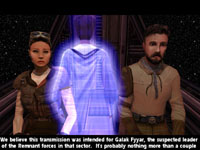 Developer:
Raven Software
Developer:
Raven Software
Producer: Lucas
Arts Entertainment Company LLC
Publisher: Activision
Price: $49.95 / $59.95 for Collector's Edition
Download
Demo
Release Date: 03/27/2002
Here I sit writing my review of Star Wars® Jedi Knight® II: Jedi Outcast™
on the eve of the release of the new Star Wars movie. I'm thinking
to myself that I enjoyed this game, but that it wasn't the "10.0" that so
many have rated it. And I'm hoping very, very much that Star Wars: Episode
II Attack of the Clones will surpass Star Wars: Episode I The Phantom
Menace as much as this game surpasses its predecessor.
Star Wars Jedi Knight II: Jedi Outcast is the sequel to LucasArts'
1997 release Star Wars Jedi Knight - Dark Forces II. The original introduced
gamers to Kyle Katarn, Jedi anti-hero, and the joy of wielding the lightsaber
and the Force in a glorious 3D. It featured an innovative technique of switching
from the 1st person view used with blasters and other weapons, to a 3rd person
view for more realistic control and self-awareness of the lightsaber. An add-on
pack, Star Wars Jedi Knight - Mysteries of the Sith, introduced new
missions, better puzzles, additional force powers and a playable female model,
the Sith apprentice Mara Jade. The add-on pack also changed gameplay significantly:
where the first title differentiated strongly between light side and dark
side force powers, the second title made all force powers neutral.
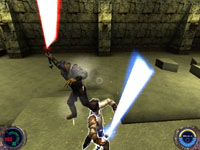 The
light side / dark side distinction is back in JKII, along with the
brooding Kyle Katarn.
The
light side / dark side distinction is back in JKII, along with the
brooding Kyle Katarn.
As our story opens he's sworn off the lightsaber and the Force , and is working
as a mercenary for the New Republic with his pilot / main squeeze, Jan Ors.
Kyle and Jan receive a garbled transmission about an Imperial Remnant searching
for the Valley of the Jedi, an immensely powerful source of Force power. Their
investigation leads them, together and apart, through military bases, secret
laboratories, the Jedi Academy, smuggler's dens, dangerous mines, enemy star
cruisers, flying cities, culminating in battles to the death with the would-be
Emperor and his Dark Jedi Master.
Graphics
 Star
Wars Jedi Knight II: Jedi Outcast features spectacular graphics, lighting,
character and set design fully consistent with the Star Wars universe.
The outdoor levels feel big, open, and immersive. The indoor levels convincingly
portray huge and detailed cityscapes, interstellar spacecraft, and landing
bays.
Star
Wars Jedi Knight II: Jedi Outcast features spectacular graphics, lighting,
character and set design fully consistent with the Star Wars universe.
The outdoor levels feel big, open, and immersive. The indoor levels convincingly
portray huge and detailed cityscapes, interstellar spacecraft, and landing
bays.
Many of the cutscenes in JKII appear to have been rendered using the
game engine itself - a technique Raven Software also used in their 3rd person
masterpiece, Heretic II. Additional techniques appear to have been
used to enhance the cutscenes; these techniques allowed the designers to create
exciting effects impossible with the engine alone.
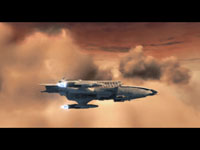 For
example, JKII features some compelling cutscenes of spacecraft flying
across a complex background. In each of these scenes, the image pixelates
as if a pre-rendered high-resolution video had been compressed to produce
a low bandwidth video stream for use in-game. The overall effect is beautiful,
despite the noticeable degradation in video quality during these cutscenes.
For
example, JKII features some compelling cutscenes of spacecraft flying
across a complex background. In each of these scenes, the image pixelates
as if a pre-rendered high-resolution video had been compressed to produce
a low bandwidth video stream for use in-game. The overall effect is beautiful,
despite the noticeable degradation in video quality during these cutscenes.
The cutscenes make great use of facial morphs and body language to convey
emotional reactions of the characters. The eyes blink, roll, and narrow. The
lips purse, smirk, and frown. In surprising contrast, the lip-synch in cutscenes
is little more than "muppet mouths" opening and closing in time
to the speech.
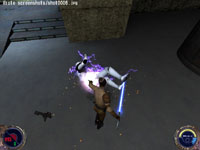 During
the game you run into the same kinds of enemies over and over again. The most
common enemies include Tuskens, Rodians, Gran, and Stormtroopers. Relatively
few skins are provided for these, and so they literally all look alike. That's
OK for the Stormtroopers, but the lack of variety in the other races sometimes
drags the story down from "adventure" to "shooter".
During
the game you run into the same kinds of enemies over and over again. The most
common enemies include Tuskens, Rodians, Gran, and Stormtroopers. Relatively
few skins are provided for these, and so they literally all look alike. That's
OK for the Stormtroopers, but the lack of variety in the other races sometimes
drags the story down from "adventure" to "shooter".
The character animations range from stiff and unnatural (for example, Kyle's
walk and run animations, or the Gran detonator-tossing animation), to smooth
and dynamic (for example, the acrobatic lightsaber dueling animations used
by Kyle, Luke, Desann, and the Dark Jedi). I especially liked some of the
mechanical animations: the movement of the protocol droids, the walker's low
and high gears.
 The
attractive dynamic lighting and volumetric shadows in JKII are pretty
par for the course from id's latest engine. Strangely, the lightsaber
doesn't cast light onto walls when dynamic lighting is enabled - an effect
that would have come in handy in more than one dark passageway.
The
attractive dynamic lighting and volumetric shadows in JKII are pretty
par for the course from id's latest engine. Strangely, the lightsaber
doesn't cast light onto walls when dynamic lighting is enabled - an effect
that would have come in handy in more than one dark passageway.
The polygon counts of the models seem just about right - things that should
be curved, look curved, and the structural models and textures combine to
produce the illusion of a highly-detailed world.
The 3rd person camera is nearly flawless, perhaps even better than it was
in Heretic II. An improvement over earlier Jedi Knight titles, JKII
allows you to switch freely between the 1st person and 3rd person views, regardless
of your weapon choice. The most noticeable camera issue occurs when Kyle is
standing with a wall immediately behind him, looking up in the 3rd person
view. In this situation moves inside Kyle, and an annoying ghost of the back-sides
of his polygons appears on-screen. The player can often eliminate this effect
by shifting Kyle's position slightly.
 Two
final notes on the graphics of JKII. First, many of the screenshots
in this review were taken with shadows and dynamic lighting turned off to
improve performance; regardless of what the box describes as the minimum system
configuration, JKII can get kind of choppy running on even a mid-tier
system with all graphics and sound options enabled. Second, screenshots taken
in JKII don't reflect the full graphic capability of the engine since
this game automatically saves screenshots using lossy JPEG compression instead
of the more detailed and disk-hungry Targa / Windows Bitmap formats.
Two
final notes on the graphics of JKII. First, many of the screenshots
in this review were taken with shadows and dynamic lighting turned off to
improve performance; regardless of what the box describes as the minimum system
configuration, JKII can get kind of choppy running on even a mid-tier
system with all graphics and sound options enabled. Second, screenshots taken
in JKII don't reflect the full graphic capability of the engine since
this game automatically saves screenshots using lossy JPEG compression instead
of the more detailed and disk-hungry Targa / Windows Bitmap formats.
Single Player Storyline
 |
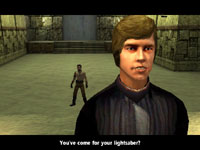 The
storyline of Star Wars Jedi Knight II: Jedi Outcast mixes fierce revenge-driven
action with a lukewarm romance and an irrelevant mystery. The plot is good
enough that it doesn't get in the way of gameplay, and it provides both a
backdrop of continuity and a path of progress for this linear adventure. It's
not so good that you find yourself playing JKII late into the night
just to find out what will happen next.
The
storyline of Star Wars Jedi Knight II: Jedi Outcast mixes fierce revenge-driven
action with a lukewarm romance and an irrelevant mystery. The plot is good
enough that it doesn't get in the way of gameplay, and it provides both a
backdrop of continuity and a path of progress for this linear adventure. It's
not so good that you find yourself playing JKII late into the night
just to find out what will happen next.
The plot features very few surprises: if you open a sealed door, you can
be pretty sure there will be either yet-another-bad-guy or some valuable inventory
item behind it. You defeat the bad guy, solve the puzzle, or die. There was
no real mystery or ambiguity to the plot (contrast this with the rampant ambiguity
of Myst, Shogo, or even Star Wars Jedi Knight - Dark Forces
II in which a player's actions and choices really had an impact on the
outcome). Even the game's "Big Plot Twist" could be predicted
by anyone familiar with how things go down in the Star Wars universe.
The main plot is simple and unoriginal, but solid. Kyle starts out as a cynical
mercenary, and undergoes a transformation in which he reclaims his birthright
as a Jedi, gradually learning to care about the greater good and increasing
his mastery of the Force in preparation for final conflict with a Dark Jedi
Master.
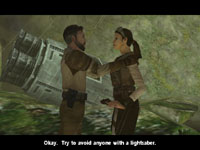 The
first subplot, Kyle's relationship with Jan, doesn't work. A romance most
likely added to help attract a female audience, it portrays Jan as a cold
fish making Kyle seem sentimental and needy. There's no growth or change in
the relationship over the course of the story, and Jan remains a cardboard
character for whom we develop little empathy. On the positive side, Jan is
portrayed as smart, competent, attractive, and witty without being dressed
as a bimbo. Jan and Kyle are separated at several points in the story, and
it might have been fun to play through those parts of the adventure from Jan's
perspective rather than Kyle's, fleshing her out as a character and exploring
the potential of the relationship a bit more.
The
first subplot, Kyle's relationship with Jan, doesn't work. A romance most
likely added to help attract a female audience, it portrays Jan as a cold
fish making Kyle seem sentimental and needy. There's no growth or change in
the relationship over the course of the story, and Jan remains a cardboard
character for whom we develop little empathy. On the positive side, Jan is
portrayed as smart, competent, attractive, and witty without being dressed
as a bimbo. Jan and Kyle are separated at several points in the story, and
it might have been fun to play through those parts of the adventure from Jan's
perspective rather than Kyle's, fleshing her out as a character and exploring
the potential of the relationship a bit more.
 The
other subplot is a Dark Jedi scheme to take over the Galaxy. Duh - like, what
else do Dark Jedi ever do? I mean, whenever there are Dark Jedi running around
in a Star Wars title, you can bet that they're trying to take over
the galaxy. As the story unfolds, cutscenes reveal more an more of the evil
plan, making connections between seemingly unrelated events and identifying
those higher and higher up the chain of responsibility. It's a mildly interesting
story, but it doesn't really impact the game - you don't act any differently,
or change your opinion of any of the story's characters, or even gain any
new abilities, as a result of what you learn in the cutscenes.
The
other subplot is a Dark Jedi scheme to take over the Galaxy. Duh - like, what
else do Dark Jedi ever do? I mean, whenever there are Dark Jedi running around
in a Star Wars title, you can bet that they're trying to take over
the galaxy. As the story unfolds, cutscenes reveal more an more of the evil
plan, making connections between seemingly unrelated events and identifying
those higher and higher up the chain of responsibility. It's a mildly interesting
story, but it doesn't really impact the game - you don't act any differently,
or change your opinion of any of the story's characters, or even gain any
new abilities, as a result of what you learn in the cutscenes.
 Because
the subplots added so little to the game, I found myself ignoring them and
simply hacking and blasting my way from level to level to get more Force powers.
Because
the subplots added so little to the game, I found myself ignoring them and
simply hacking and blasting my way from level to level to get more Force powers.
The story is laced with pleasant cameo appearances by familiar characters
from the Star Wars universe: Lando Clarissian, Luke Skywalker, bungling
Stormtroopers, arrogant Imperial officers, and talkative droids. There's also
a bar fight, a narrow escape from a trash compactor, and text scrolling obliquely
into the screen to help complete the Star Wars mood.
Gameplay - Single Player
Kyle is a former Jedi who has sworn never again to use the Force. He changes
his mind about the Force early in the game, and has to learn how to use and
develop his powers all over again. This works out really well for the player,
who also has to learn how to control and use Kyle's powers offensively, defensively,
and to solve puzzles.
The first few levels of JKII are pretty boring and tedious to play,
but they're effective as a short course in how to use the various projectile
weapons and Force powers. Each level builds on skills you've learned in previous
levels, and challenges you to apply them creatively.
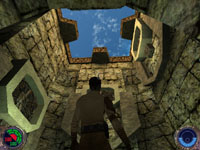 The
game gets a lot more interesting once you recover Kyle's lightsaber from the
Jedi Temple. You find yourself feeling genuinely super-human, looking at previously
insurmountable obstacles and thinking, "I'm glad I'm a Jedi". You
also see more powerful characters using the Force in ways that you can't,
and find yourself wanting their powers.
The
game gets a lot more interesting once you recover Kyle's lightsaber from the
Jedi Temple. You find yourself feeling genuinely super-human, looking at previously
insurmountable obstacles and thinking, "I'm glad I'm a Jedi". You
also see more powerful characters using the Force in ways that you can't,
and find yourself wanting their powers.
To control Kyle, you use the keyboard and the mouse. The basic movement controls
will be familiar to anyone who has ever played an adventure / shooter based
on a Quake-style engine. Kyle's Force powers are controled by another set
of keys, by default F1 - F7. This arrangement can be a little awkward during
gameplay if your other key bindings are the default: your right hand is on
the mouse, while your left hand is on the strafe / crouch / jump / use / run
cluster at the lower right of the keyboard, making it a long reach to the
Force power keys at the upper right. The best solution is to experiment with
the key bindings until you find a layout that's comfortable and easy to use.
Finding a usable keyboard layout is only moderately important in Single Player
mode; it will be much more important in Deathmatch.
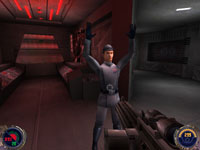 There
are thirteen types of personal weapons in JKII, and they can be grouped into
melee weapons, projectile weapons, and throwable weapons. There's no limit
on the number of weapons you can carry, but there is a maximum ammo count
for each weapon type. The weapons do varying types of damage and most have
a normal and an alternate firing mode. The first person view works best for
the projectile weapons; the 3rd person view works best for the others. You
can switch between the views at any time by pressing P.
There
are thirteen types of personal weapons in JKII, and they can be grouped into
melee weapons, projectile weapons, and throwable weapons. There's no limit
on the number of weapons you can carry, but there is a maximum ammo count
for each weapon type. The weapons do varying types of damage and most have
a normal and an alternate firing mode. The first person view works best for
the projectile weapons; the 3rd person view works best for the others. You
can switch between the views at any time by pressing P.
The melee weapons are:
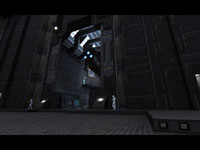 You'll
find more to playing JKII than just killing enemies. The game includes
many puzzles - some clever, some just annoying.
You'll
find more to playing JKII than just killing enemies. The game includes
many puzzles - some clever, some just annoying.
More than half of the puzzles in JKII are jumping or gauntlet puzzles.
I despise this kind of puzzle, in which your character must jump from platform
to platform using very precise timing, or dodge rapidly moving objects, either
dying or having to start the whole sequence over if even one mistake is made.
There's very little thought involved in creating or solving most jumping or
gauntlet puzzles, and I really wish game designers would cut back on their
use in future titles. Although JKII over-uses this type of puzzle,
Raven added some nice touches: you have to use the Force creatively to solve
some; others include alternative paths that lead to shortcuts or secret areas.
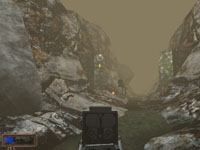 Roughly
a quarter of the puzzles in JKII are maze puzzles. Slightly less cliche
than jumping puzzles, maze puzzles require your character to find his way
through confusing terrain or a complex structure, with many dead end paths
and only one correct path. The maze puzzles in JKII are player-friendly,
but challenging. For example, your obective might be to find a certain spaceship
in a huge docking complex, or a certain temple in a rugged wilderness. In
each case, you're solving a subtle maze puzzle, but you also have multiple
secondary obstacles to overcome on the way. Kudos to Raven on making the mazes
in JKII fade into the background.
Roughly
a quarter of the puzzles in JKII are maze puzzles. Slightly less cliche
than jumping puzzles, maze puzzles require your character to find his way
through confusing terrain or a complex structure, with many dead end paths
and only one correct path. The maze puzzles in JKII are player-friendly,
but challenging. For example, your obective might be to find a certain spaceship
in a huge docking complex, or a certain temple in a rugged wilderness. In
each case, you're solving a subtle maze puzzle, but you also have multiple
secondary obstacles to overcome on the way. Kudos to Raven on making the mazes
in JKII fade into the background.
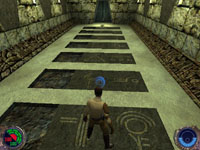 The
other 25% of the puzzles in JKII are genuinely inspired. In one of
these pleasantly surprising puzzles, you have to prevent a droid from being
destroyed by trip mines while under heavy enemy fire. In another, you must
use Force powers to open an ancient combination lock. Another can only be
solved by combining several Force powers at once. Yet another requires you
to move by stealth - no killing - through an indoor area filled with enemy
soldiers. Uncommon puzzles like these separate a mediocre single-player game
from a great single-player game in my book, and I'm pleased that JKII
includes several.
The
other 25% of the puzzles in JKII are genuinely inspired. In one of
these pleasantly surprising puzzles, you have to prevent a droid from being
destroyed by trip mines while under heavy enemy fire. In another, you must
use Force powers to open an ancient combination lock. Another can only be
solved by combining several Force powers at once. Yet another requires you
to move by stealth - no killing - through an indoor area filled with enemy
soldiers. Uncommon puzzles like these separate a mediocre single-player game
from a great single-player game in my book, and I'm pleased that JKII
includes several.
 Star
Wars Jedi Knight II: Jedi Outcast provides several game difficulty settings.
The default setting is for medium game difficulty, and players familiar with
games like Heretic II or Quake 3 Arena should have no trouble
playing through the game at this difficulty level (although I recommend saving
your game frequently). Keep in mind that there seems to be a limit of roughly
100 saved games in JKII, after which the setup screen will no longer display
newly saved games for reloading. If you find that some of your saved games
aren't showing in the setup screen, try deleting some previously saved games
or moving these older saved games to another folder.
Star
Wars Jedi Knight II: Jedi Outcast provides several game difficulty settings.
The default setting is for medium game difficulty, and players familiar with
games like Heretic II or Quake 3 Arena should have no trouble
playing through the game at this difficulty level (although I recommend saving
your game frequently). Keep in mind that there seems to be a limit of roughly
100 saved games in JKII, after which the setup screen will no longer display
newly saved games for reloading. If you find that some of your saved games
aren't showing in the setup screen, try deleting some previously saved games
or moving these older saved games to another folder.
Gameplay - Multiplayer
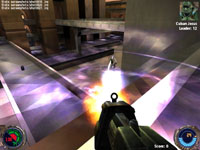 Star
Wars Jedi Knight II: Jedi Outcast includes seven multiplayer modes, decent
ranged weapon and melee bots, and a built-in LAN / internet game browser with
map voting. The multiplayer modes feature configurable game parameters, seven
additional Force powers, and four additional pick-up items.
Star
Wars Jedi Knight II: Jedi Outcast includes seven multiplayer modes, decent
ranged weapon and melee bots, and a built-in LAN / internet game browser with
map voting. The multiplayer modes feature configurable game parameters, seven
additional Force powers, and four additional pick-up items.
The additional Force powers provide team-oriented Jedi capabilities, and
also allow players to configure their powers to favor either the Dark Side
or the Light Side of the Force. They are:
 Capture
the Flag is a team-based multiplayer mode in which two teams attempt to
keep both their own flag and a stolen enemy flag at their own base. This game
mode has been implemented either as a built-in or as a mod in many other adventure
/ shooter games, and it works as expected. Gameplay tends toward the fast
and furious in this mode. The maps provided by Raven are well laid-out, with
several distinct paths to and from the base. The Raven maps are spacious,
and seem to have been designed for a relatively large number of players (at
least five on each team). Many internet servers run this mode continuously,
with high player load factors.
Capture
the Flag is a team-based multiplayer mode in which two teams attempt to
keep both their own flag and a stolen enemy flag at their own base. This game
mode has been implemented either as a built-in or as a mod in many other adventure
/ shooter games, and it works as expected. Gameplay tends toward the fast
and furious in this mode. The maps provided by Raven are well laid-out, with
several distinct paths to and from the base. The Raven maps are spacious,
and seem to have been designed for a relatively large number of players (at
least five on each team). Many internet servers run this mode continuously,
with high player load factors.
 Capture
the Ysalamiri is a variation of Capture the Flag. It uses identical rules,
but adds a Force-damping Ysalamiri lizard to the top of the pole of each team's
flag. The Ysalamiri assures that whoever is carrying the flag cannot use the
Force, and that no force-based attacks can be used against the flag-bearer.
This changes the game dynamic significantly, leading to increased use of conventional
weapons and decreased use of the Force during the game. Capture the Ysalamiri
uses the same maps as Capture the Flag, but we found only a few internet servers
running this game mode - perhaps because players would rather have full access
to Force powers at all times.
Capture
the Ysalamiri is a variation of Capture the Flag. It uses identical rules,
but adds a Force-damping Ysalamiri lizard to the top of the pole of each team's
flag. The Ysalamiri assures that whoever is carrying the flag cannot use the
Force, and that no force-based attacks can be used against the flag-bearer.
This changes the game dynamic significantly, leading to increased use of conventional
weapons and decreased use of the Force during the game. Capture the Ysalamiri
uses the same maps as Capture the Flag, but we found only a few internet servers
running this game mode - perhaps because players would rather have full access
to Force powers at all times.
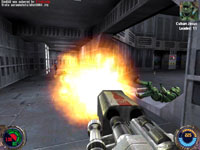 Free
For All is just what you'd expect - no teams, and everyone is an enemy
to be killed for points. It works the same as any nearly other game's deathmatch
mode, with the addition of an innovative lightsaber challenge feature. This
feature allows two players to duel using only lightsabers, regardless of anything
else going on in the game. One player challenges, another accepts, and from
that point these two players can use only the lightsaber and force powers
until one of them dies. The duelists are also immune to weapon attacks and
Force powers of other players, and can't attack or use the Force on other
players. In addition to providing a cool in-game twist, the lightsaber challenge
feature allows nearly any deathmatch map to be used for lightsaber dueling.
Free For All seems to be the most common mode running on internet servers.
Free
For All is just what you'd expect - no teams, and everyone is an enemy
to be killed for points. It works the same as any nearly other game's deathmatch
mode, with the addition of an innovative lightsaber challenge feature. This
feature allows two players to duel using only lightsabers, regardless of anything
else going on in the game. One player challenges, another accepts, and from
that point these two players can use only the lightsaber and force powers
until one of them dies. The duelists are also immune to weapon attacks and
Force powers of other players, and can't attack or use the Force on other
players. In addition to providing a cool in-game twist, the lightsaber challenge
feature allows nearly any deathmatch map to be used for lightsaber dueling.
Free For All seems to be the most common mode running on internet servers.
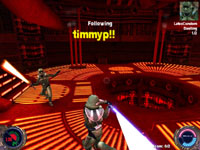 Duel
mode provides a structured environment for one-on-one lightsaber duels. Only
two players are active at a given time, with the rest assigned a place in
line waiting to fight. The active players fight each other with the lightsaber
and force powers. The waiting players chat with each other and move around
the map invisibly as observers (freelook) or follow combatants (chasecam).
The maps provided for this mode are smaller than Deathmatch or CTF/CTY maps,
since there are only two combatants, there's no sniping, and there's little
advantage to hiding. The advantage of Duel mode is that it is "llama-proof"
- it's very difficult for a player to deliberately disrupt the duels. The
disadvantages of Duel mode are that the waiting players can't see each
other or interact other than through chat, and that the waiting time between
duels can be ten minutes or more on a heavily loaded server. We found a good
variety of internet servers running Duel mode during our tests, although
not as many as run Capture the Flag or Deathmatch.
Duel
mode provides a structured environment for one-on-one lightsaber duels. Only
two players are active at a given time, with the rest assigned a place in
line waiting to fight. The active players fight each other with the lightsaber
and force powers. The waiting players chat with each other and move around
the map invisibly as observers (freelook) or follow combatants (chasecam).
The maps provided for this mode are smaller than Deathmatch or CTF/CTY maps,
since there are only two combatants, there's no sniping, and there's little
advantage to hiding. The advantage of Duel mode is that it is "llama-proof"
- it's very difficult for a player to deliberately disrupt the duels. The
disadvantages of Duel mode are that the waiting players can't see each
other or interact other than through chat, and that the waiting time between
duels can be ten minutes or more on a heavily loaded server. We found a good
variety of internet servers running Duel mode during our tests, although
not as many as run Capture the Flag or Deathmatch.
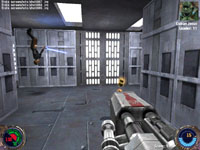 Holocron
uses the same rules as Free For All. In addition, players start with no Force
powers, and Force power-ups known as holocrons are placed at strategic
points on the map. Each Force power has its own style of holocron, and when
a player picks up a holocron he's able to use that Force power until he is
killed or exceeds the limit of three holocrons. When a player is killed, his
holocrons respawn on the spot; when a player picks up more than three holocrons,
the one he has been using longest respawns on the spot. If not picked up within
30 seconds, these holocrons vanish and respawn at their original spawn points
on the map. Only a handful of internet servers were running this mode during
our tests.
Holocron
uses the same rules as Free For All. In addition, players start with no Force
powers, and Force power-ups known as holocrons are placed at strategic
points on the map. Each Force power has its own style of holocron, and when
a player picks up a holocron he's able to use that Force power until he is
killed or exceeds the limit of three holocrons. When a player is killed, his
holocrons respawn on the spot; when a player picks up more than three holocrons,
the one he has been using longest respawns on the spot. If not picked up within
30 seconds, these holocrons vanish and respawn at their original spawn points
on the map. Only a handful of internet servers were running this mode during
our tests.
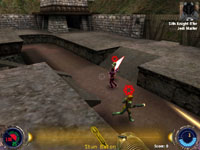 Jedi
Master is a king-of-the-hill mode. One lightsaber is placed on the map;
whoever gets it first becomes a Jedi Master with full Force powers, while
the other players have only weapons and shields. The Jedi Master scores by
killing other players, while the other players score by killing the Jedi Master.
A player who kills the Jedi Master becomes the next Jedi Master. This continues
until a frag limit or time limit is reached. This is a very fast-paced game,
since typically the Jedi Master is surrounded by other players when he's killed,
and these players immediately attack the new Jedi Master. On internet servers,
this mode appears to be more popular than CTY or Holocron, but less popular
than the other modes.
Jedi
Master is a king-of-the-hill mode. One lightsaber is placed on the map;
whoever gets it first becomes a Jedi Master with full Force powers, while
the other players have only weapons and shields. The Jedi Master scores by
killing other players, while the other players score by killing the Jedi Master.
A player who kills the Jedi Master becomes the next Jedi Master. This continues
until a frag limit or time limit is reached. This is a very fast-paced game,
since typically the Jedi Master is surrounded by other players when he's killed,
and these players immediately attack the new Jedi Master. On internet servers,
this mode appears to be more popular than CTY or Holocron, but less popular
than the other modes.
 Team
Free For All works like Free For All, but the players are grouped into
two teams and earn points only for killing members of the other team. The
strategy for Team Free For All is made unique by the new Force powers
that support team cooperation. For example, players with high scores in Force
Team Heal or Force Team Energize are able to significantly assist and rejuvinate
teammates during offensives. This game tends to favor small groups of teammates
with compatible Force powers who move around the map trying to isolate and
kill enemy players.
Team
Free For All works like Free For All, but the players are grouped into
two teams and earn points only for killing members of the other team. The
strategy for Team Free For All is made unique by the new Force powers
that support team cooperation. For example, players with high scores in Force
Team Heal or Force Team Energize are able to significantly assist and rejuvinate
teammates during offensives. This game tends to favor small groups of teammates
with compatible Force powers who move around the map trying to isolate and
kill enemy players.
Overall JKII provides a rich multiplayer gaming experience right out
of the box. Be sure to check the Raven and LucasArts websites for the latest
game patches, since some servers are now running patched 1.03 versions of
JKII that are incompatible with the original.
Sound
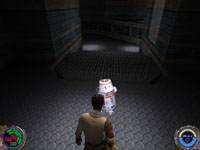 The
character voices in JKII kit the mark, following Star Wars' almost
operatic conventions: low-pitched, British-accented or alien voices for the
bad guys, higher-pitched, American-accented voices for the good guys. Billy
Dee Williams provides the authentic voice of Lando Clarissian, while Bob Bergen
delivers a believable rendition of Luke Skywalker. The voice acting is good,
although with flatter delivery and much less variety in vocal style and use
of regional dialects than, say, Monolith's Aliens vs. Predator 2.
The
character voices in JKII kit the mark, following Star Wars' almost
operatic conventions: low-pitched, British-accented or alien voices for the
bad guys, higher-pitched, American-accented voices for the good guys. Billy
Dee Williams provides the authentic voice of Lando Clarissian, while Bob Bergen
delivers a believable rendition of Luke Skywalker. The voice acting is good,
although with flatter delivery and much less variety in vocal style and use
of regional dialects than, say, Monolith's Aliens vs. Predator 2.
Whether you're hearing the arcane beeps and whistles of an R4 droid, the
dynamic whir and buzz of a lighsaber, or the raw crushing power of an Imperial
Walker in motion, the mechanical sound effects are great. Weapons fire sounds
just right for each weapon; you never think a weapon sound effect in JKII
is either exaggerated or wimpy. Many of the sound effects are taken directly
from the original Star Wars soundtrack to create a perfect fit.
 The
sound effects are perfectly matched to movements and background events, and
nothing seems out of place in the ambient sound of the various game levels.
John Williams' Star Wars music permeates the cutscenes and backgrounds.
The music and sound effects are moving, authentic and familiar, but certainly
don't break any new ground or push the envelope.
The
sound effects are perfectly matched to movements and background events, and
nothing seems out of place in the ambient sound of the various game levels.
John Williams' Star Wars music permeates the cutscenes and backgrounds.
The music and sound effects are moving, authentic and familiar, but certainly
don't break any new ground or push the envelope.
Overall the sound work in JKII makes a strong contribution to mood and realism,
reinforcing the Star Wars feel while maintaining high technical standard.
I found that even with reduced performance settings, the sound cut in and
out or broke up during gameplay when a lot was going on; play this game on
a high-end system to get the full impact of the sound work. A patch released
by Raven adds improved EAX positional sound support. You can download this
patch from the Raven or LucasArts sites.
Value
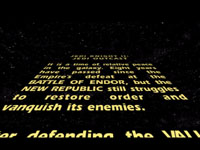 There's
not much in Star Wars Jedi Knight II: Jedi Outcast that you haven't
already seen somewhere else - whether in a Star Wars movie, or in some
other adventure / shooter game. Priced comparably to other current titles,
it's a great value if you're looking for a classic Star Wars gaming
experience built on a modern 3D engine.
There's
not much in Star Wars Jedi Knight II: Jedi Outcast that you haven't
already seen somewhere else - whether in a Star Wars movie, or in some
other adventure / shooter game. Priced comparably to other current titles,
it's a great value if you're looking for a classic Star Wars gaming
experience built on a modern 3D engine.
The single-player game is interesting and challenging enough that you'll
consider playing it again on a higher difficulty setting or to find more of
the secret areas, while the game's seven multiplayer modes offer many hours
of on-line entertainment. Players without fast internet connections, or who
prefer to hone their skills in private, can take advantage of all of the game
modes using the built-in bot support.
System Requirements
System Requirements:



